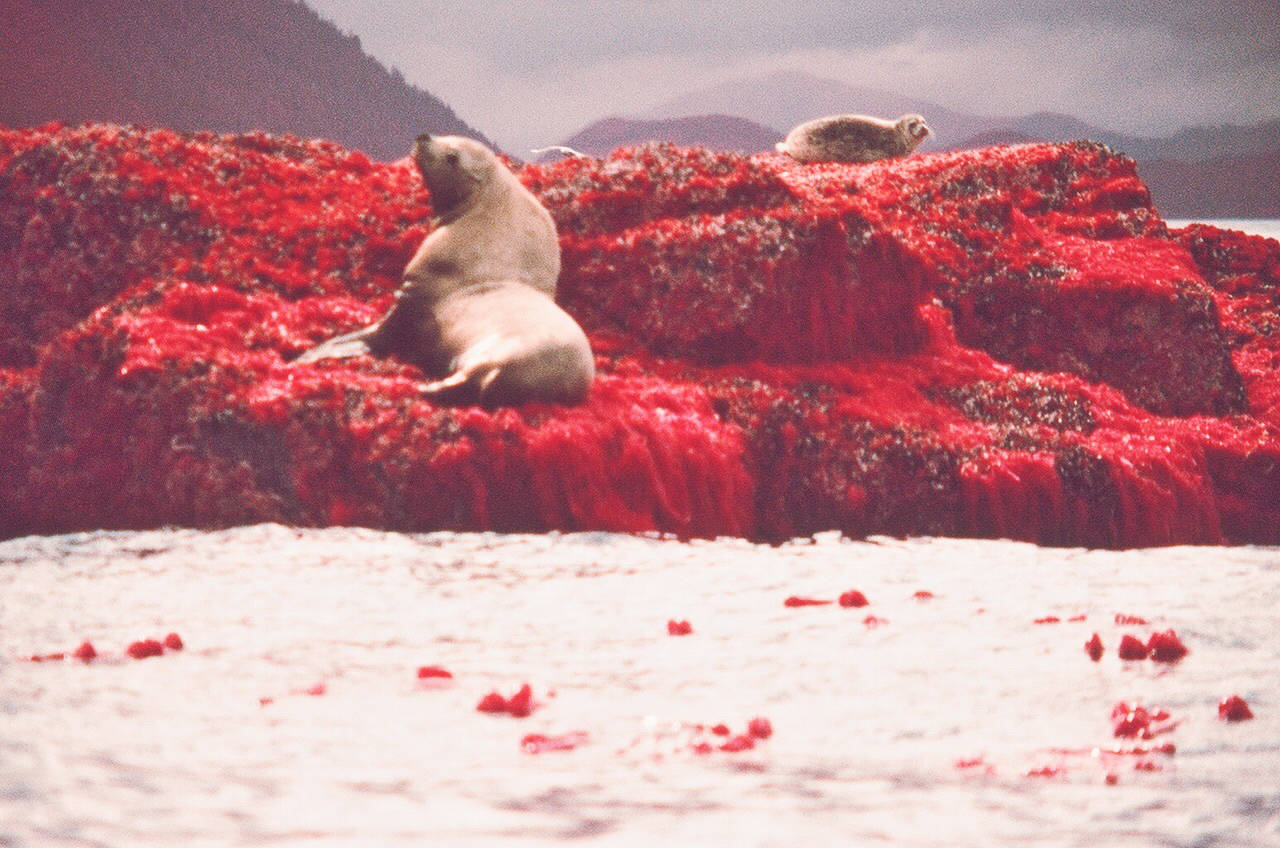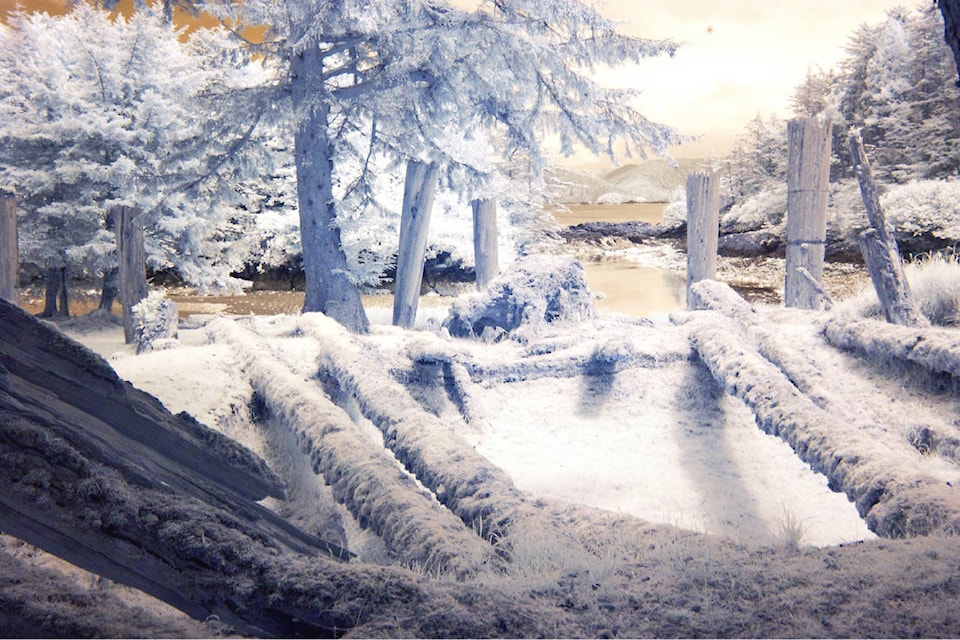Rémy Olivier Robin is picturing Haida Gwaii in a light that no one can really see.
This summer, the 21-year-old artist toured Haida Gwaii taking photos in infrared.
Using an old twin-lens film camera and a modified digital one, Robin photographed sea lions and black bears, Tow Hill and Balance Rock, and the Haida village sites at SG̱ang Gwaay, K’uuna (Skedans), T’aanuu, and Windy Bay (Hlk’yah GawG̱a).
Now, along with slides and stereoscopic 3D images, Robin is developing some of those infrared photos using gum bichromate — an early form of colour printing popular in the 1870s, when George Dawson and others were taking the first wet-plate photographs of Haida villages.
“It’s not to necessarily to rewrite history, but to go back into that time period and do a similar project with more respect in mind, rather than just documenting from the colonizer’s point of view,” Robin says.
Just as infrared film shows something real but unseen, Robin’s project aims to get people thinking about how Haida culture was seen and misperceived.
Growing up in Seattle, Robin saw a few Haida artefacts at the Seattle Art Museum and the Burke Museum of Natural History and Culture.
He saw many more after enrolling at the School of Art Institute of Chicago — right next door is the Field Museum, where Robin was surprised to find over 200 Haida artefacts, one of the largest collections in the world.
Robin watched Stolen Spirits of Haida Gwaii, a 2003 documentary about the Haida repatriation committee and its ongoing efforts to bring back Haida ancestral remains, grave materials, and ancient treasures. He has spoken with Dr. Helen Robbins, director of repatriation at the Field, as well as with staff at the Haida Gwaii Museum, and has thought about cultural appropriation.
He has also been criticized for it himself.
PNWt First Nations Eagle is a large formline woodcarving of an eagle crest by Robin, who is not Indigenous, inlaid with hand-blown neon glass that flashes patterns over the sound of eagle chirps and calls.
“Some people really love it, and they think I should bring it here and donate it to the museum,” he said.
“Some people have reacted with anger, which is understandable after years of exploitation.”
“Without having met me first, they don’t know what my intentions are.”
For Haida Gwaii in Infrared, Robin sought permission from the Council of the Haida Nation a year before he arrived. He offered most of the proceeds from any print or related media sales to the CHN and the SHIP program in Skidegate.
Robin is also getting ready to collaborate with Massett artist Skiilaw/Captain Stewart-Burton on carving a Victorian-era wood stereoscope out of red cedar harvested by Taan Forest, to show some of his infrared photos in stereoscopic 3D.
The plan is to display the device somewhere on Graham Island.
Robin is aware there is cultural tension in the project, right down to the infrared film he is using.
Called Aerochrome, it was originally developed for aerial surveys of farmland, but later used by the U.S. military in the Vietnam War.
When most people think “infrared,” they might imagine super-bright reds and pinks.
Those are the colours that Kodak, a film company, chose to represent infrared light on Aerochrome.
“It’s a false-colour film,” Robin said.
Because fresh green leaves don’t absorb infrared light, but reflect it all back, Aerochrome not only showed U.S. farmers the health of their crops, it later gave U.S. bombers a way to spot camouflage over the forests of Vietnam.
Discontinued in 2009, the Aerochrome rolls Robin used for Haida Gwaii in Infrared were actually cut for U.S. military cameras.
Re-purposing them one more time wasn’t easy.
Shooting infrared film means Robin can’t check his focus in the camera’s viewfinder, and he basically needs direct sunlight — a rarity on Haida Gwaii, especially this summer.
Not only is it pricey because it’s among the last remaining Aerochrome in the world, Robin’s eight-year-old rolls are also about to expire.
“I keep a freezer box with me everywhere,” he said, laughing.
“If it’s in room temperature for more than seven days, it’s gone.”
When learning to print in gum bichromate, it took Robin a full day to make just one — and that was his fortieth try. The process is something like developing a one full-colour image from 10 single-colour layers, each made with watercolours set in liquid gum.
Making a stereoscopic image is also tricky. Familiar to some through ViewMaster toys, it involves placing two slide photos exactly an eyeball-distance apart in a viewing device so that the brain of whoever peers inside will unconsciously reassemble them as a three-dimensional image.
“I was amazed by the concept that just seeing two pictures somehow makes a 3D image,” Robin said.
Ironically, Robin is also expert in Photoshop. He knows he could fake a gum bichromate or an infrared image faster than someone can say “hashtag No Filter.”
“We live in a world where you can doctor any image,” he said.
“That what I want people to see when I bring the stereoscope — this isn’t Photoshop.”
“What I want to do is make not only vivid pictures, but ones you can literally enter.”
Images from Haida Gwaii in Infrared will soon be available at remyolivier.com.
The project will go on display at Chicago’s Sullivan galleries from March 11 to 31, and if anyone on Haida Gwaii wants to see more or discuss it, Robin is available through the contact page on his website.

